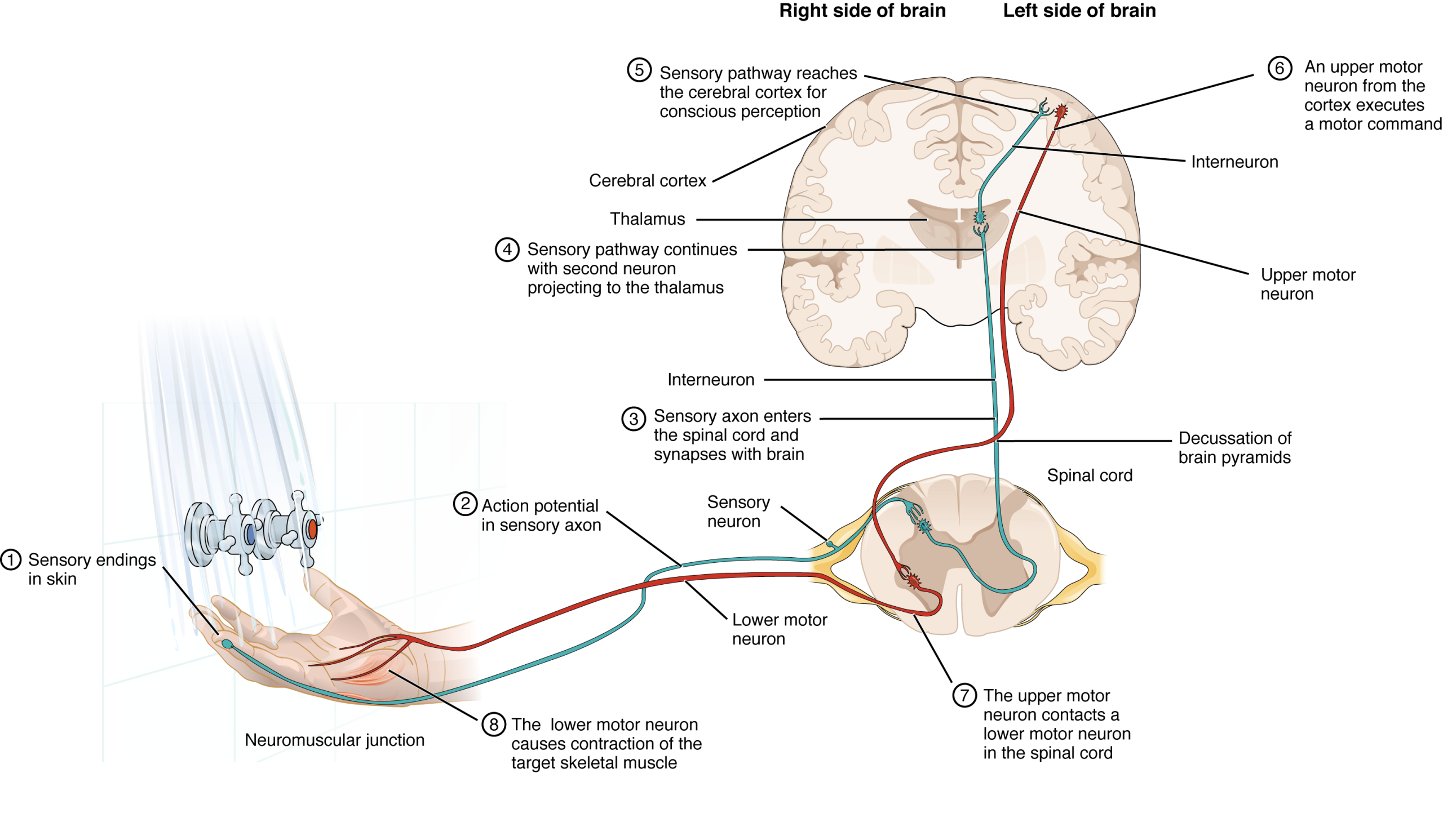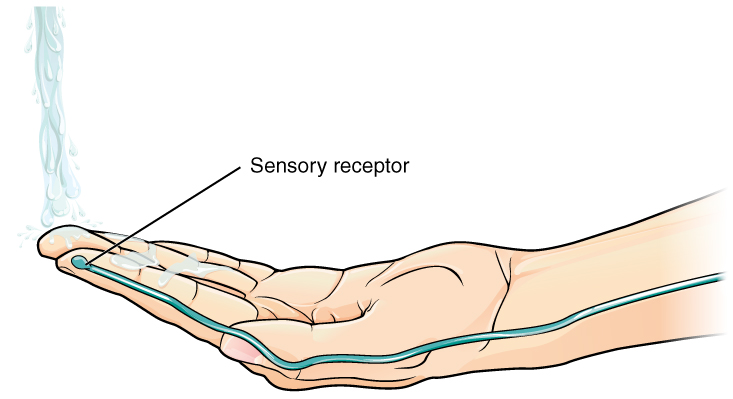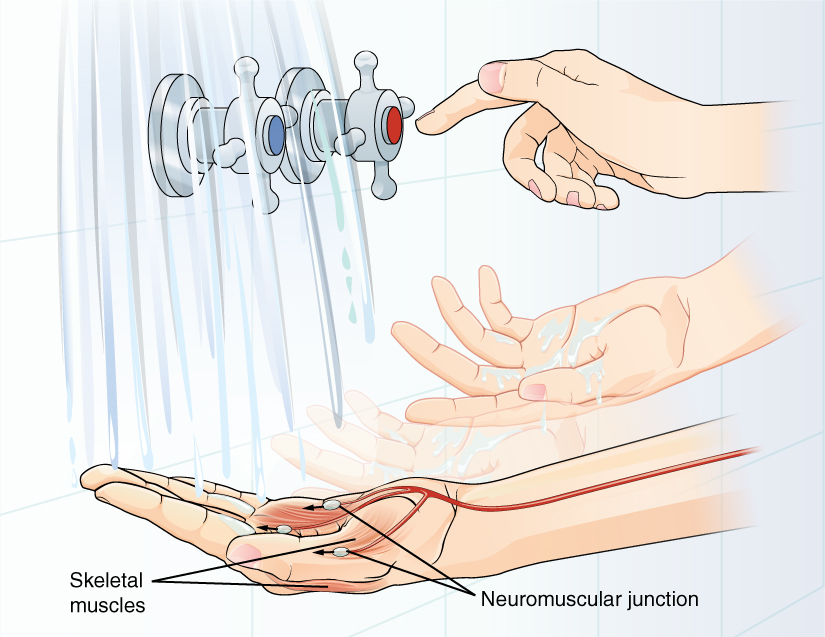Chapter 5. The Nervous System and Nervous Tissue
5.3 The Function of Nervous Tissue
Learning Objectives
By the end of this section, you will be able to:
- Describe the pathway involved with neural sensation, integration, and motor response
Having looked at the components of nervous tissue and the basic anatomy of the nervous system, next comes an understanding of how nervous tissue is capable of communicating within the nervous system. Before getting to the nuts and bolts of how this works, an illustration of how the components come together will be helpful. An example is summarized in Figure 5.3.1. The general concepts apply to various examples, but the brain regions involved will differ.

Imagine you are about to take a shower in the morning before going to school. You have turned on the faucet to start the water as you prepare to get in the shower. You put your hand out into the spray of water to test the temperature. What happens next depends on how your nervous system interacts with the stimulus of the water temperature and what you do in response to that stimulus.
Found in the skin is a type of sensory receptor that is sensitive to temperature, called a thermoreceptor. When you place your hand under the shower (Label 1 in Figure 5.3.1, close up in Figure 5.3.2), the cell membrane of the thermoreceptors changes its electrical state (voltage). The amount of change is dependent on the strength of the stimulus (in this example, how hot the water is). This is called a graded potential. If the stimulus is strong, the voltage of the cell membrane will change enough to generate an electrical signal that will travel down the axon. The voltage at which such a signal is generated is called the threshold, and the resulting electrical signal is called an action potential. In this example, the action potential travels—a process known as propagation—along the axon from the initial segment found near the receptor to the axon terminals and into the synaptic end bulbs in the central nervous system (Label 2 in Figure 5.3.1). When this signal reaches the end bulbs, it causes the release of a signaling molecule called a neurotransmitter.

In the central nervous system (in this case, the spinal cord), the neurotransmitter diffuses across the short distance of the synapse and binds to a receptor protein of the target neuron. When the neurotransmitter binds to the receptor, the cell membrane of the target neuron changes its electrical state and a new graded potential begins. If that graded potential is strong enough to reach threshold, the second neuron generates an action potential at its initial segment (Label 3 in Figure 5.3.1). The target of this neuron is another neuron in the thalamus of the brain, the part of the CNS that acts as a relay for sensory information. At this synapse, neurotransmitter is released and binds to its receptor. The thalamus then sends the sensory information to the cerebral cortex, the outermost layer of gray matter in the brain, where conscious perception of that water temperature begins.
Within the cerebral cortex, information is processed among many neurons, integrating the stimulus of the water temperature with other sensory stimuli, as well as with your emotional state and memories. Finally, a plan is developed about what to do, whether that is to turn the temperature up, turn the whole shower off and go back to bed, or step into the shower. To do any of these things, the cerebral cortex has to send a command out to your body to move muscles.
A region of the cortex is specialized for sending signals down to the spinal cord for movement. The upper motor neuron starts in this region, called the precentral gyrus of the frontal cortex, and has an axon that extends all the way down the spinal cord. The upper motor neuron synapses in the spinal cord with a lower motor neuron, which directly stimulates muscle fibers to contract. In the manner described in the chapter on muscle tissue, an action potential travels along the motor neuron axon into the periphery. The lower motor neuron axon terminates on muscle fibers at the neuromuscular junction. Acetylcholine is the neurotransmitter released at this specialized synapse, and binding to receptors on the muscle cell membrane causes the muscle action potential to begin. When the lower motor neuron excites the muscle fiber, the muscle contracts (Figure 5.3.3). All of this occurs in a fraction of a second, but this story is the basis of how the nervous system functions.

Career Connections – Neurophysiologist
There are many pathways to becoming a neurophysiologist. One path is to become a research scientist at an academic institution. A bachelor’s degree will get you started, and for neurophysiology that might be in biology, psychology, computer science, engineering, or neuroscience. But the real specialization comes in graduate school. There are many different programs out there to study the nervous system besides just neuroscience itself. Most graduate programs are doctoral and are usually considered five-year programs, with the first two years dedicated to course work and finding a research mentor and the last three years dedicated to finding a research topic and pursuing that. The research will usually result in a few publications in scientific journals, which will make up the bulk of a doctoral dissertation. After graduating with a Ph.D., researchers will go on to find specialized work called a postdoctoral fellowship within established labs. In this position, a researcher starts to establish their own research career with the hopes of finding an academic position at a research university.
Other options are available if you are interested in how the nervous system works. Especially for neurophysiology, a medical degree might be more suitable so you can learn about the clinical applications of neurophysiology. Biotechnology firms are eager to find motivated scientists ready to tackle the tough questions about how the nervous system works so that therapeutic chemicals can be tested on some of the most challenging disorders, such as Alzheimer’s disease, Parkinson’s disease, or spinal cord injury.
Others with a medical degree and a specialization in neuroscience go on to work directly with patients, diagnosing and treating mental disorders. You can do this as a psychiatrist, a neuropsychologist, a neuroscience nurse, or a neurodiagnostic technician, among other possible career paths.
Section Review
Sensation starts with the activation of a sensory receptor, such as the thermoreceptor in the skin sensing the temperature of the water. The sensory receptor in the skin initiates an electrical signal that travels along a sensory axon within a nerve into the spinal cord, where it synapses with a neuron in the gray matter of the spinal cord. At the synapse the temperature information represented in that electrical signal is passed to the next neuron by a chemical signal (the neurotransmitter) that diffuses across the small gap of the synapse and initiates a new electrical signal. That signal travels through the sensory pathway to the brain, synapsing in the thalamus, and finally the cerebral cortex where conscious perception of the water temperature occurs. Following integration of that information with other cognitive processes and sensory information, the brain sends a command back down to the spinal cord to initiate a motor response by controlling a skeletal muscle. The motor pathway is composed of two cells, the upper motor neuron and the lower motor neuron. The upper motor neuron has its cell body in the cerebral cortex and synapses with the lower motor neuron in the gray matter of the spinal cord. The axon of the lower motor neuron extends into the periphery, where it synapses with a skeletal muscle fiber at a neuromuscular junction.
Review Questions
Critical Thinking Questions
Glossary
- action potential
- change in voltage of a cell membrane in response to a stimulus that results in transmission of an electrical signal; unique to neurons and muscle fibers
- graded potential
- change in the membrane potential that varies in size, depending on the size of the stimulus that elicits it
- neurotransmitter
- chemical signal that is released from the synaptic end bulb of a neuron to cause a change in the target cell
- propagation
- movement of an action potential along the length of an axon
- thermoreceptor
- a type of sensory receptor found in the skin that is sensitive to temperature
- threshold
- membrane voltage at which an action potential is initiated
Glossary Flashcards
This work, Human Physiology, is adapted from Anatomy & Physiology by OpenStax, licensed under CC BY. This edition, with revised content and artwork, is licensed under CC BY-SA except where otherwise noted.
Images from Anatomy & Physiology by OpenStax are licensed under CC BY except where otherwise noted.
Access the original for free at OpenStax.
Image Descriptions
Figure 5.3.1. This diagram illustrates the parallel pathways of sensory and motor neurons traveling through the spinal cord and brain, numbered sequentially from 1 to 8. The sensory pathway, shown in teal/blue, begins at step 1 with sensory endings in the skin on the lower left, depicted as specialized receptors in layered tissue. At step 2, an action potential travels along the sensory axon of a sensory neuron. At step 3, the sensory axon enters the spinal cord and synapses with an interneuron and continues to the brain. At step 4, the sensory pathway continues with a second neuron projecting through the brainstem to the thalamus in the center of the brain. At step 5, the sensory pathway reaches the cerebral cortex on the right side of the brain for conscious perception. The motor pathway, shown in red/dark red, runs in the opposite direction. At step 6, an upper motor neuron from the left cerebral cortex executes a motor command and descends through the brain. The pathway shows “decussation of brain pyramids” where motor fibers cross from the left side to the right side of the brainstem. At step 7, the upper motor neuron contacts a lower motor neuron in the spinal cord. Finally, at step 8, the lower motor neuron extends to the neuromuscular junction where it causes contraction of the target skeletal muscle. An interneuron is shown connecting the sensory and motor pathways within the spinal cord, demonstrating reflex arc connections. This diagram effectively illustrates how sensory information ascends from the body to the brain while motor commands descend from the brain to muscles. [Return to Figure 5.3.1]
Figure 5.3.2. This illustration shows a cross-sectional view of a human hand with the palm facing upward, revealing the internal structure of sensory nerve pathways beneath the skin. The diagram highlights a sensory receptor located near the surface of the fingertip, labeled with a pointer. From this receptor, teal/blue nerve fibers are shown traveling through the layers of skin tissue in the finger and palm, then continuing up through the wrist and into the forearm. The illustration demonstrates how sensory information detected at the fingertips is transmitted through peripheral nerves toward the central nervous system. The skin layers are depicted in beige/peach tones, showing the epidermis and deeper tissue layers, while the nerve pathways are clearly visible as distinct blue lines running along the length of the hand and arm. [Return to Figure 5.3.2]
Figure 5.3.3. This three-panel illustration demonstrates a sensory-motor reflex pathway from stimulus to response. The top panel shows a hand reaching toward a shower faucet with an exploded view highlighting the temperature control knob in red. The middle panel depicts the hand under flowing water, receiving the temperature stimulus. The bottom panel reveals a cross-sectional view of the forearm and hand’s internal anatomy, showing a red motor neuron axon traveling down the forearm and branching as it reaches the hand. Each axon branch synapses with different skeletal muscles at the neuromuscular junction, where nerve signals trigger muscle contraction. This impulse causes the skeletal muscles to contract, enabling the hand to adjust the faucet dials and change the water temperature. The sequence illustrates the complete reflex arc from detecting water temperature to producing a coordinated motor response. [Return to Figure 5.3.3]
Report an Error
Did you find an error, typo, broken link, or other problem in the text? Please follow this link to the error reporting form to submit an error report to the authors.
